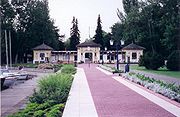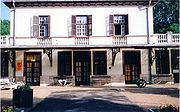
Balatonföldvár
Encyclopedia
Balatonföldvár is a small town in Somogy county, Hungary
. It is situated on the south side of Lake Balaton
, approximately 120 km southwest from Budapest
. It was settled relatively recently by modern man (mid-to-late 19th century), however, archeologists found objects in the area dating back to the late Stone Age.
The locals sometimes refer to the town by the name Földvár, without using the Balaton prefix.
(part of present day Budapest) to the Italian peninsula. This road was considered one of the important roads of the Roman province of Pannonia
. Pannonia incorporates the area occupied by modern day Hungary west of the Danube.
In the 14th and 15th centuries, the area of today’s Balatonföldvár consisted mostly of pasture land. In terms of jurisdiction, it was attached to the settlement of Kőröshegy, located about three kilometers south of the lake. The entire region around Kőröshegy was purchased and belonged to the Archbishop, György Széchényi since 1677. The oldest known building which is said to have belonged to Balatonföldvár, was the ‘földvári csárda’, namely, the inn of Földvár. This inn was supposed to have existed from about the middle of the 18th century to the late 19th century.
The name Földvár appeared around 1893, used by Zsigmond Széchényi, the owner of the area at the time. The inn was eventually demolished and a new one was built in its place. The Holovits family rented this inn, enlarged the building with additions and eventually established a more modern restaurant and a small hotel there.
The Széchényi family may be considered as the most influential family, which directed the expansion of the town starting in the late 19th century. Balatonföldvár was eventually developed into a high profile holiday resort. Many rich and influential people from the capital city had lavish villas built there. Several small hotels were established. Sailing became a pastime of the rich and famous. Beautiful gardens had been established. The design and management of these gardens was the work of Ilona Jordanits, who was a horticulturalist. Her efforts contributed to Balatonföldvár winning the 1995 European prize, as the city with the most flowers.
.
.jpg)

.jpg) Two curved piers were built in the early 20th century to provide a protected harbor for sailboats and ships. The harbor was dredged and the material from there was used to create an artificial island, called the Galamb Sziget (Pigeon Island). The name is derived from the decorative pigeon sties mounted on the small bridge used to cross from the mainland to the island. The island has a number of poplar trees and footpaths, but otherwise it was never developed further.
Two curved piers were built in the early 20th century to provide a protected harbor for sailboats and ships. The harbor was dredged and the material from there was used to create an artificial island, called the Galamb Sziget (Pigeon Island). The name is derived from the decorative pigeon sties mounted on the small bridge used to cross from the mainland to the island. The island has a number of poplar trees and footpaths, but otherwise it was never developed further.
After the Communist takeover of Hungary (1948), the area of the Galamb Sziget, the hotel close by and the eastern pier were made inaccessible to the general public. This area was reserved for Communist Party members who came there for the summer holidays. Because of the high security, the area acquired a special air of mystique.
After the regime change in the early 1990s, the authorities opened up this area to the public. However, a new high-rise hotel (Hotel Festival) was built there and only registered guests have access to the grounds. Once again, the eastern pier is off limits to the public. The Galamb Sziget, on the other hand, is open to all.
.
 Balatonföldvár was beautified with an impressive promenade bordered by a double row of sycamore trees along the western part of the town. The harbor was also developed, allowing tour ships to operate from there to other communities around the lake. The view of the north shore is breathtaking. Standing on the western pier, one can see a number of conical hills on the other side, and the flat, table like mountain of Badacsony
Balatonföldvár was beautified with an impressive promenade bordered by a double row of sycamore trees along the western part of the town. The harbor was also developed, allowing tour ships to operate from there to other communities around the lake. The view of the north shore is breathtaking. Standing on the western pier, one can see a number of conical hills on the other side, and the flat, table like mountain of Badacsony
, a famous wine producing area. The hills of the Tihany
peninsula appear much closer. The lower slopes of these dark treed hills are covered with the purple haze of flowering lavender fields during the summer season. Sailboats dot the horizon.
.

 When arriving by train, this building appears unexpectedly for the traveler. It was built in 1928. In the pre-war days it was an imposing building, well proportioned and symmetrical, painted in yellow and kept immaculately clean.
When arriving by train, this building appears unexpectedly for the traveler. It was built in 1928. In the pre-war days it was an imposing building, well proportioned and symmetrical, painted in yellow and kept immaculately clean.
Nowadays there is a ticket office, where one can buy a trip to Budapest or other destinations, however, there is no more station manager employed by the Hungarian National Railways (MÁV
).
.
.
Hungary
Hungary , officially the Republic of Hungary , is a landlocked country in Central Europe. It is situated in the Carpathian Basin and is bordered by Slovakia to the north, Ukraine and Romania to the east, Serbia and Croatia to the south, Slovenia to the southwest and Austria to the west. The...
. It is situated on the south side of Lake Balaton
Lake Balaton
Lake Balaton is a freshwater lake in the Transdanubian region of Hungary. It is the largest lake in Central Europe, and one of its foremost tourist destinations. As Hungary is landlocked , Lake Balaton is often affectionately called the "Hungarian Sea"...
, approximately 120 km southwest from Budapest
Budapest
Budapest is the capital of Hungary. As the largest city of Hungary, it is the country's principal political, cultural, commercial, industrial, and transportation centre. In 2011, Budapest had 1,733,685 inhabitants, down from its 1989 peak of 2,113,645 due to suburbanization. The Budapest Commuter...
. It was settled relatively recently by modern man (mid-to-late 19th century), however, archeologists found objects in the area dating back to the late Stone Age.
Name
The town received its name from the combination of 'Balaton' and ‘földvár’, which is the Hungarian word for a defensive structure made of clay or soil, fortified by wood. The ‘földvár’ was built in the late Iron Age, during the occupation of the Celts. Most of this structure was eventually washed away by the lake.The locals sometimes refer to the town by the name Földvár, without using the Balaton prefix.
History
The region around Lake Balaton had been occupied around 11 BCE by the Romans and provided passage for a military road from AquincumAquincum
The ancient city of Aquincum was situated on the North-Eastern borders of the Pannonia province within the Roman Empire. The ruins of the city can be found today in Budapest, the capital city of Hungary...
(part of present day Budapest) to the Italian peninsula. This road was considered one of the important roads of the Roman province of Pannonia
Pannonia
Pannonia was an ancient province of the Roman Empire bounded north and east by the Danube, coterminous westward with Noricum and upper Italy, and southward with Dalmatia and upper Moesia....
. Pannonia incorporates the area occupied by modern day Hungary west of the Danube.
In the 14th and 15th centuries, the area of today’s Balatonföldvár consisted mostly of pasture land. In terms of jurisdiction, it was attached to the settlement of Kőröshegy, located about three kilometers south of the lake. The entire region around Kőröshegy was purchased and belonged to the Archbishop, György Széchényi since 1677. The oldest known building which is said to have belonged to Balatonföldvár, was the ‘földvári csárda’, namely, the inn of Földvár. This inn was supposed to have existed from about the middle of the 18th century to the late 19th century.
The name Földvár appeared around 1893, used by Zsigmond Széchényi, the owner of the area at the time. The inn was eventually demolished and a new one was built in its place. The Holovits family rented this inn, enlarged the building with additions and eventually established a more modern restaurant and a small hotel there.
The Széchényi family may be considered as the most influential family, which directed the expansion of the town starting in the late 19th century. Balatonföldvár was eventually developed into a high profile holiday resort. Many rich and influential people from the capital city had lavish villas built there. Several small hotels were established. Sailing became a pastime of the rich and famous. Beautiful gardens had been established. The design and management of these gardens was the work of Ilona Jordanits, who was a horticulturalist. Her efforts contributed to Balatonföldvár winning the 1995 European prize, as the city with the most flowers.
.
The Balatonföldvár harbor
.jpg)

.jpg)
After the Communist takeover of Hungary (1948), the area of the Galamb Sziget, the hotel close by and the eastern pier were made inaccessible to the general public. This area was reserved for Communist Party members who came there for the summer holidays. Because of the high security, the area acquired a special air of mystique.
After the regime change in the early 1990s, the authorities opened up this area to the public. However, a new high-rise hotel (Hotel Festival) was built there and only registered guests have access to the grounds. Once again, the eastern pier is off limits to the public. The Galamb Sziget, on the other hand, is open to all.
.
The view of the northern shore of Lake Balaton from Balatonföldvár

Badacsony
Badacsony is the name of a region on the north shore of Lake Balaton in western Hungary, and a town in that region. The entire area is recognized for its wine, with vineyards dating back to Roman times....
, a famous wine producing area. The hills of the Tihany
Tihany
Tihany is a village on the northern shore of Lake Balaton on the Tihany Peninsula . The whole peninsula is a historical district....
peninsula appear much closer. The lower slopes of these dark treed hills are covered with the purple haze of flowering lavender fields during the summer season. Sailboats dot the horizon.
.
Railway station


Nowadays there is a ticket office, where one can buy a trip to Budapest or other destinations, however, there is no more station manager employed by the Hungarian National Railways (MÁV
MAV
The acronym/initialism MAV may have several meanings, including:*Mathematical Association of Victoria of Victoria, Australia*Municipal Association of Victoria of Victoria, Australia*Micro air vehicle, a type of remotely controlled unmanned aerial vehicle...
).
.
Present
Balatonföldvár is a major tourist destination, not only for Hungarians, but also for tourists from other European countries. There are close to eighty hotels and privately rented apartments available for the visitor. The town's infrastructure is modern, with water treatment and sewerage plant, cable TV, wireless service, good roads, walking paths, parks, medical service, restaurants, pharmacy and shops. Cultural life is prolific, with music recitals being offered in the Roman Catholic Church, open air theatre and other venues. The town is often used as a venue for conferences..

